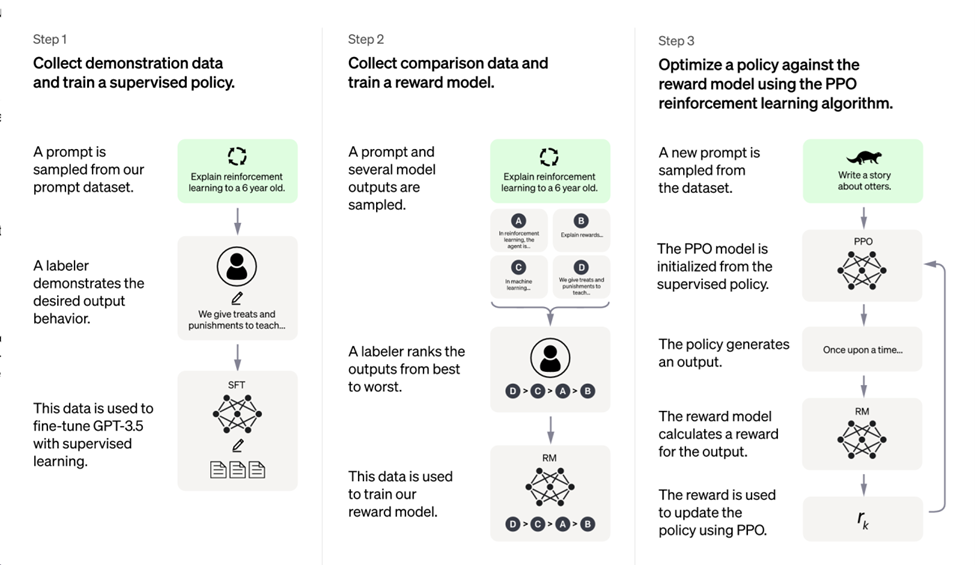ผลของการใช้ ChatGPT ร่วมกับการเรียนการสอนวิชาคณิตศาสตร์ในระดับปริญญาตรี
Main Article Content
บทคัดย่อ
งานวิจัยชิ้นนี้มีวัตถุประสงค์เพื่อ 1) เปรียบเทียบผลสัมฤทธิ์ทางการเรียนเนื้อหาวิชาคณิตศาสตร์ของผู้เรียนที่เรียนควบคู่กับการใช้งาน ChatGPT และผู้เรียนที่เรียนแบบบรรยายปกติ 2) วัดความพึงพอใจการใช้งาน ChatGPT ในการเรียนควบคู่การบรรยายเนื้อหาวิชาคณิตศาสตร์สำหรับกลุ่มทดลอง โดยการวิจัยนี้เป็นงานวิจัยเชิงปริมาณ (Quantitative Research Methodology) มีแบบแผนการวิจัยเป็นแบบเชิงทดลองแบบแท้จริง (True Experimental Research Design) ประชากรในงานวิจัยนี้คือ นักศึกษาระดับปริญญาตรีต่อเนื่อง 2-3 ปี ชั้นปีที่ 1 ปีการศึกษา 2566 วิทยาลัยเทคโนโลยีอุตสาหกรรม มหาวิทยาลัยเทคโนโลยีพระจอมเกล้าพระนครเหนือ กลุ่มตัวอย่างคือ นักศึกษาระดับปริญญาตรีต่อเนื่อง 2-3 ปี ที่ลงเรียนในรายวิชาการคำนวณพื้นฐานทางคณิตศาสตร์ด้วยโปรแกรมพื้นฐาน ภาคเรียนที่ 1/2566 จำนวน 72 คน แบ่งกลุ่มตัวอย่างเป็นกลุ่มควบคุมและกลุ่มทดลองโดยมีการทดสอบเพื่อการเปรียบเทียบโดยใช้แบบทดสอบก่อนเรียนและหลังเรียน จากผลการทดลองพบว่า ผลการเปรียบเทียบที่ได้จากแบบทดสอบก่อนเรียนของทั้งสองกลุ่มไม่แตกต่างกันโดยกลุ่มทดลองมีค่า = 10.89, S.D. = 4.55 กลุ่มควบคุมมีค่า
= 10.44, S.D. = 4.80 (* p > .05 และ
) จากนั้นใช้ ChatGPT-3.5 เข้ามาร่วมในการเรียนการสอนห้องของกลุ่มทดลอง และทำการเรียนการสอนเนื้อหาแบบปกติในห้องของกลุ่มควบคุมแล้วทำการทดสอบหลังเรียน พบว่า กลุ่มทดลองมีค่า
= 17.89, S.D. = 2.95 กลุ่มควบคุมมีค่า
= 14.56, S.D. = 3.23 (* p/2 > .05 และ
) จึงสามารถสรุปได้ว่ากลุ่มทดลองที่ได้รับการสอนควบคู่กับการใช้ ChatGPT มีความเข้าใจในเนื้อหามากกว่ากลุ่มควบคุมที่ผ่านการเรียนการสอนแบบปกติ และจากการประเมินความพึงพอใจการใช้งาน ChatGPT พบว่าผลการประเมินทั้งหมดอยู่ในระดับพึงพอใจมาก
Article Details

อนุญาตภายใต้เงื่อนไข Creative Commons Attribution-NonCommercial-NoDerivatives 4.0 International License.
เอกสารอ้างอิง
กระทรวงศึกษาธิการ, สำนักงานคณะกรรมการการอาชีวศึกษา. (2563). หลักสูตรประกาศนียบัตรวิชาชีพชั้นสูง พุทธศักราช 2563. กรุงเทพฯ: สำนักงานคณะกรรมการการอาชีวศึกษา.
วศิน เพิ่มทรัพย์และโชค วิศวโยธิน. (2566). ChatGPT AI ปฏิวัติโลก. กรุงเทพฯ: โปรวิชั่น.
สันติ หุตมาน. (2022). การศึกษาผลสัมฤทธิ์ทางการเรียนโดยใช้รูปแบการเรียนรู้ MIAP ร่วมกับชุดสาธิตและการจำลองการทำงานรายวิชาการขับเคลื่อนด้วยไฟฟ้าและระบบเซอร์ โว. วารสารศึกษาศาสตร์ มหาวิทยาลัยขอนแก่น, 45(1), 32-43.
สำนักงานสถิติแห่งชาติ. (2564). อัตราการเรียนต่อระดับมัธยมศึกษาและอุดมศึกษา ปีการศึกษา 2559-2563. สสช สำนักงานสถิติแห่งชาติ. http://statbbi.nso.go.th/staticreport/page/sector/th/03.aspx.
Amity Solutions. (2023). Chat GPT คืออะไร? 42 ข้อเท็จจริงที่คุณอาจไม่เคยรู้!. ค้นเมื่อ 28 พฤศจิกายน 2566, จาก https://www.amitysolutions.com/th/blogs/what-is-chat-gpt.
Biswas, S. (2023). Role of Chat GPT in Education. Available at SSRN 4369981.
Chen, L., Chen, P., & Lin, Z. (2020). Artificial intelligence in education: A review. Ieee Access, 8, 75264-75278.
Entrepreneur staff. (2023). ChatGPT: What Is It and How Does It Work?. Entrepreneur. https://www.entrepreneur.com/science-technology/chatgpt-what-is-it-and-how-does-it-work/445014.
Firat, M. (2023). How chat GPT can transform autodidactic experiences and open education. Department of Distance Education. Open Education Faculty, Anadolu Unive.
Plevris, V., Papazafeiropoulos, G., & Rios, A. J. (2023). Chatbots put to the test in math and logic problems: A preliminary comparison and assessment of ChatGPT-3.5, ChatGPT-4, and Google Bard. arXiv preprint arXiv:2305.18618.
Wardat, Y., Tashtoush, M. A., AlAli, R., & Jarrah, A. M. (2023). ChatGPT: A revolutionary tool for teaching and learning mathematics. Eurasia Journal of Mathematics, Science and Technology Education, 19(7), em2286.


